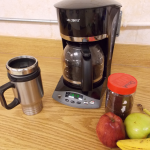by Heidi Copeland | May 9, 2013

Make half your grains whole with homemade whole grain bread.
One of the most comforting memories of childhood has to be the smell of homemade yeast bread wafting throughout the house! Baking yeast bread, like many other kitchen traditions is making a comeback. Bread is a wonderful source of carbohydrades, especially if the flour is made from whole grains. (These kernels consist of three parts: the bran, the embryo and the endosperm). Eating breads made with whole grain flour can help you Make Half Your Grains Whole, as the dietary guidelines recommend.
However, the traditional yeast bread making method – proof yeast, knead dough, rise, punch down, rest, form, rise again, and bake….is being debunked!
I’ve been experimenting with many of the recipes in Artisan Bread in Five Minutes a Day and Healthy Bread in Five Minutes a Day mostly to find a simple experience for baking yeast breads with children during 4-H summer camps. However, my experiments have been so successful that I have asked permission from Publicity @St. Martin’s Press to actually publish the master recipe as long as I give credit where credit is due.
There are those out there, myself included, that swear by the discovery of Jeff Hertzberg, M.D., and Zoë Francois that Artisan Bread can indeed be made in just five minutes of “active effort” every day.
The aforementioned authors published their first book in 2007. Currently, they have three best-selling cookbooks on the market, all of which are a very practical guide to producing delicious artisan bread and bread products that require a minimal of basic ingredients: flour, water, yeast and salt. The equipment is nominal too: measuring cups and spoons, a large storage container with a lid, a sturdy mixing tool and of course sheets or pans and an oven to bake your bread in. Of course there are other gadgets but none as necessary as what is listed.
Specifically, the authors choose the French boule (“boule” in French means “ball”) as the basic model for bread making as the shape is easy to form, the taste delicious and quite nutritious.
If you are interested in giving this process a try you can find the recipe in its entirety by clicking here Master Bread Recipe.pdf
by Elaine Courtney | Apr 24, 2013
 Have you ever been in this situation? You are with friends and they suggest going somewhere for dinner. Your finances are tight and you really can’t afford to eat out at the pricey place suggested. What would you do?
Have you ever been in this situation? You are with friends and they suggest going somewhere for dinner. Your finances are tight and you really can’t afford to eat out at the pricey place suggested. What would you do?
1. Admit you don’t have the funds and say, “I really can’t afford it.”
2. Keep quiet and go along—you’ll just order an appetizer and water.
3. You enjoy being with friends so go ahead and buy what you want!
Saying those words, “I can’t afford it,” is something many have struggled with at one time or another. Some may feel shame or embarrassment if they utter those words. But there’s nothing wrong with saying it! Money issues are often difficult to discuss or verbalize. Perhaps rephrasing it would help– “That’s out of my price range right now.”
It is important to be honest with yourself about what you can afford. Facing reality may be difficult but it can reduce your financial stress. Would you rather confront things now or when you are struggling to pay your credit card bill? However, do you even know if you can afford it?
Everybody needs to learn how to manage money. Good money management includes being able to pay your monthly bills, save for the future, and buy the things you need and want without creating unmanageable debt. A spending plan can be a helpful money management tool. For resources on spending plans and more, click here.
You probably have noticed that different people have different attitudes about money. Some people want to collect as much as they can, while others want to buy as many goods and services as they can. Recognizing your attitude about money can help you deal with situations where you say, “I can’t afford it.”
Recent articles by Jean Chatzky and the Wall Street Journal discussed having to admit when you can’t afford something.
Here are some tips for saying “I can’t afford it:”
• Know your situation and what you will say when presented with an offer: “Let me check my budget/spending plan.” “Let me think about that.” “That’s not in my plan for today. Maybe another time.”
• Understand the emotions that are involved. Friends often get their feelings hurt if you never want to go with them. Explaining your plans in advance can often help you avoid misunderstandings.
• Peer pressure encourages us to spend money when we can’t afford it. The constant barrage of advertisements or friends, family, or co-workers can exert pressure to part with your money. When you have a clear understanding of your money and financial goals, it may make it easier to resist. But it is not always easy!
Knowing and understanding your finances will help you find the courage to say, “I can’t afford it” or “That’s out of my price range.”
by Monica Brinkley | Apr 23, 2013
Se lf-control is an important skill for all children to learn. In other words, individuals know right from wrong or have power to control their own actions. Self-control is the ability to think before you act, rather than being controlled by your feelings. Children who rely on parents or other children to make choices for them do not learn self-control.
lf-control is an important skill for all children to learn. In other words, individuals know right from wrong or have power to control their own actions. Self-control is the ability to think before you act, rather than being controlled by your feelings. Children who rely on parents or other children to make choices for them do not learn self-control.
Often times, these children may follow others’ bad choices and not take responsibility for the consequences of their behavior. When the child is young, this causes many frustrations. As they grow, the problems can grow as well and the consequences can become more and more serious, even leading to self-destructive behavior like the use of drugs and alcohol. Therefore, it is very important to start young to build the skills that children will need later in life.
Self-control lessons start in the first year of life, but it is never too late to help a child build more self-control. Research shows that when you respond predictably to an infant who cries, later on that baby is likely to cry less rather than more. So you need to get to know your baby’s style of soothing.
Toddlerhood is a demanding time for parent and child. Many toddlers become frustrated because they may have trouble making themselves understood or may be too little to do the things they want to do. Expect toddlers to have little self-control.
Children behave best by keeping them on a regular schedule as much as possible. Help them get enough rest and serve regular meals and snacks. At this age, children are very distractible – you can redirect them to another activity when they are doing something unsafe. If your child has a temper tantrum, make sure they are safe and keep them from hurting themselves or others. After the tantrum is over, they need comfort and support. Teach some basic words, such as NO and STOP, to use in difficult situations. The goal of self-control at this age is to help children begin to use words to express themselves.
During the preschool years, children are eager to play with others their own age, but it is rarely smooth. The goal of this stage of development is to learn how to talk about a problem and solve it with words rather than aggressions. Encourage children to say what the problem is and ask them to come up with ideas for a solution. As long as all the children involved agree, let them try out their own solutions.
This is the time to introduce family chores. Simple jobs like setting the table and putting away laundry are good for children at this age. Research has found that children who have regular chores from the age of four are more successful in early adulthood.
The work of helping your child build self-control continues through the elementary school years and into the teen years. Children learn to be responsible by handling homework, family chores, and obligations to friends and family. Starting early and carrying on self-control lessons throughout your child’s developing years is the best way to give the gift of healthy self-control.
by Heidi Copeland | Apr 17, 2013

Two-thirds of American household waste is due to food spoilage
Sustainability – 1. The ability to be sustained, supported, upheld, or confirmed. 2. Environmental Science: The quality of not being harmful to the environment or depleting it.
This Earth Day, think about the dictionary definitions of sustainability, especially as they relate to consumer choices. Take food, for instance. As a nation, not only are we becoming super-sized but so is our food-related waste. In August 2012, the Natural Resources Defense Council (NRDC) reported that Americans are throwing away 40 percent of their food supply in the U.S. every year. The reasons for this problem are multifaceted. Nevertheless, consumers are a major contributor to the problem. Key findings include:
- The average American family of four ends up throwing away an equivalent of up to $2,275 annually in food (I’ve started to tally up my own family waste and believe me, it adds up! Leftovers not eaten in time, half a can of evaporated milk, brown lettuce, wilted carrots, yellowing broccoli, etc…)
- In average American households, two-thirds of household waste is due to food spoilage
- 40 percent of fresh fish
- 23 percent of eggs
- 20 percent of milk
- Citrus fruits and cherries top the list for fruits, and sweet potatoes, onions, and greens are commonly wasted vegetables
- Much of household waste is due to over purchasing, food spoilage, and plate waste.
- One-third is caused by people cooking or serving too much (Package size, serving size, and dishware size all influence how much each of us eats).
Wasted food also translates into wasted natural resources because of the energy, water, and farmland necessary to grow, transport, and store food. Additionally, food waste is the single largest component of solid waste in U.S. landfills.
Every one of us can be a facet in solving this increasing problem. Each person can waste less food by:
- shopping wisely
- knowing when/how food goes bad
- eating produce that is perfectly edible even if it’s less cosmetically attractive (much of this is thrown out)
- cooking only the amount of food you can reasonably eat
- eating leftovers (consider them a bonus for lunch tomorrow)
Norman Vincent Peale says, Change your thoughts and you change your world. Can the same thinking apply to our behavior? If each and every one of us made a small behavior change, it could help change the world.
For more information: http://www.nrdc.org/food/wasted-food.asp
http://www.nrdc.org/living/eatingwell/saving-leftovers-saves-money-resources.asp
by Amy Mullins, PhD, RDN | Apr 10, 2013
Normal
0
false
false
false
EN-US
X-NONE
X-NONE
/* Style Definitions */
table.MsoNormalTable
{mso-style-name:”Table Normal”;
mso-tstyle-rowband-size:0;
mso-tstyle-colband-size:0;
mso-style-noshow:yes;
mso-style-priority:99;
mso-style-parent:””;
mso-padding-alt:0in 5.4pt 0in 5.4pt;
mso-para-margin-top:0in;
mso-para-margin-right:0in;
mso-para-margin-bottom:10.0pt;
mso-para-margin-left:0in;
line-height:115%;
mso-pagination:widow-orphan;
font-size:11.0pt;
font-family:”Calibri”,”sans-serif”;
mso-ascii-font-family:Calibri;
mso-ascii-theme-font:minor-latin;
mso-hansi-font-family:Calibri;
mso-hansi-theme-font:minor-latin;}

Check your blood pressure regularly to monitor hypertension.
For World Health Day on April 7, the World Health Organization (WHO) chose to highlight high blood pressure as a major public health concern. This chronic disease is responsible for increasing the risk for heart disease and stroke, which are the leading causes of death in the United States. The Centers for Disease Control and Prevention (CDC) estimate that 68 million (1 in 3 adults) in the United States have high blood pressure, also known as hypertension. Because many people show no signs or symptoms of the disease, hypertension is known as a “silent killer” because people often don’t realize they have it.
Having your blood pressure checked regularly is the only way to know if you have a problem. Checking your blood pressure is easy. Your doctor will do this during regular visits, or you can find an automatic blood pressure machine at most pharmacies and major grocery stores. Do you know what your numbers should look like?
Normal
0
false
false
false
EN-US
X-NONE
X-NONE
/* Style Definitions */
table.MsoNormalTable
{mso-style-name:”Table Normal”;
mso-tstyle-rowband-size:0;
mso-tstyle-colband-size:0;
mso-style-noshow:yes;
mso-style-priority:99;
mso-style-parent:””;
mso-padding-alt:0in 5.4pt 0in 5.4pt;
mso-para-margin-top:0in;
mso-para-margin-right:0in;
mso-para-margin-bottom:10.0pt;
mso-para-margin-left:0in;
line-height:115%;
mso-pagination:widow-orphan;
font-size:11.0pt;
font-family:”Calibri”,”sans-serif”;
mso-ascii-font-family:Calibri;
mso-ascii-theme-font:minor-latin;
mso-hansi-font-family:Calibri;
mso-hansi-theme-font:minor-latin;}
|
Blood Pressure Levels
|
|
Normal
|
Systolic: less than 120 mmHg
Diastolic: less than 80 mmHg
|
|
At risk (pre-hypertension)
|
Systolic: 120–139 mmHg
Diastolic: 80–89 mmHg
|
|
High
|
Systolic: 140 mmHg or higher
Diastolic: 90 mmHg or higher
|
Normal
0
false
false
false
EN-US
X-NONE
X-NONE
/* Style Definitions */
table.MsoNormalTable
{mso-style-name:”Table Normal”;
mso-tstyle-rowband-size:0;
mso-tstyle-colband-size:0;
mso-style-noshow:yes;
mso-style-priority:99;
mso-style-parent:””;
mso-padding-alt:0in 5.4pt 0in 5.4pt;
mso-para-margin-top:0in;
mso-para-margin-right:0in;
mso-para-margin-bottom:10.0pt;
mso-para-margin-left:0in;
line-height:115%;
mso-pagination:widow-orphan;
font-size:11.0pt;
font-family:”Calibri”,”sans-serif”;
mso-ascii-font-family:Calibri;
mso-ascii-theme-font:minor-latin;
mso-hansi-font-family:Calibri;
mso-hansi-theme-font:minor-latin;}
What Can You Do?
Many factors can influence your blood pressure, which is defined as the force of blood against your artery walls during circulation. Although hypertension risk can be hereditary and tends to increase as we get older, many other factors can be controlled to reduce your risk of developing the disease. The CDC identifies the use of tobacco or alcohol, as well as being overweight, not getting enough daily physical activity, and excessive dietary sodium as controllable risk-factors.
- Take action to manage your weight by reducing excess calories, fat, and sugar.
- Increase your physical activity everyday, even if it is just walking 30 minutes a day.
- If you smoke, stop now.
- If you consume alcohol, do so in moderation.
- Reduce your sodium intake.
Most sodium in the American diet comes from salt added during food processing. The Dietary Guidelines for Americans (2010) recommends reducing daily sodium intake to no more than 2,300 milligrams (mg) for adults, and to no more than 1,500 mg for persons over the age of 51, African Americans, or those with diabetes or chronic kidney disease. Americans can reduce their sodium consumption in several ways:
- Read the Nutrition Facts label for the sodium content of purchased products and look for lower sodium options.
- Consume more fresh foods and fewer processed foods, such as canned soups, cured meats, condiments, and prepackaged meals.
- Eat more home-prepared meals, where you have more control over added salt. Don’t use seasonings that contain sodium.
- When dining out, ask that salt not be added or choose lower-sodium options, if available.
Don’t wait. Check your blood pressure today and talk to your doctor if you are concerned about your risk for developing chronic hypertension. For more information about lifestyle changes and hypertension, click here. For information on reading labels and ideas on how to cook with less sodium, click here.
Normal
0
false
false
false
EN-US
X-NONE
X-NONE
/* Style Definitions */
table.MsoNormalTable
{mso-style-name:”Table Normal”;
mso-tstyle-rowband-size:0;
mso-tstyle-colband-size:0;
mso-style-noshow:yes;
mso-style-priority:99;
mso-style-parent:””;
mso-padding-alt:0in 5.4pt 0in 5.4pt;
mso-para-margin-top:0in;
mso-para-margin-right:0in;
mso-para-margin-bottom:10.0pt;
mso-para-margin-left:0in;
line-height:115%;
mso-pagination:widow-orphan;
font-size:11.0pt;
font-family:”Calibri”,”sans-serif”;
mso-ascii-font-family:Calibri;
mso-ascii-theme-font:minor-latin;
mso-hansi-font-family:Calibri;
mso-hansi-theme-font:minor-latin;}
References:
Normal
0
false
false
false
EN-US
X-NONE
X-NONE
/* Style Definitions */
table.MsoNormalTable
{mso-style-name:”Table Normal”;
mso-tstyle-rowband-size:0;
mso-tstyle-colband-size:0;
mso-style-noshow:yes;
mso-style-priority:99;
mso-style-parent:””;
mso-padding-alt:0in 5.4pt 0in 5.4pt;
mso-para-margin-top:0in;
mso-para-margin-right:0in;
mso-para-margin-bottom:10.0pt;
mso-para-margin-left:0in;
line-height:115%;
mso-pagination:widow-orphan;
font-size:11.0pt;
font-family:”Calibri”,”sans-serif”;
mso-ascii-font-family:Calibri;
mso-ascii-theme-font:minor-latin;
mso-hansi-font-family:Calibri;
mso-hansi-theme-font:minor-latin;}
The Centers for Disease Control and Prevention, High Blood Pressure. http://www.cdc.gov/bloodpressure/index.htm
U.S. Department of Agriculture and U.S. Department of Health and Human Services. Dietary Guidelines for Americans, 2010. 7th Edition, Washington, DC: U.S. Government Printing Office, December 2010. http://www.dietaryguidelines.gov
Linda B. Bobroff, PhD, RD, LD/N, professor and Extension nutrition specialist; Department of Family, Youth and Community Sciences; , Nutrition for Health and Fitness: Sodium in Your Diet. Institute of Food and Agricultural Sciences; University of Florida, September 2012. http://edis.ifas.ufl.edu/he696
by Kristin Jackson | Apr 3, 2013

Could this be one of the germiest places in your home?
In 2011, NSF International, an independent, not-for-profit organization, conducted a study with 22 families and analyzed 30 items in their homes. One item that disappointingly made NSF International’s list of the “Top Ten Germiest Places in the Home” was the coffee reservoir. This could be sad news for the approximately 239 million individuals, or 83 percent of American adults, who drank coffee in the US in 2012 (National Coffee Association).
Perk up, coffee drinkers. The good news is the solution is easy: simply clean your coffee maker according to the manufacturer’s instructions and then sanitize. Cleaning will wash/wipe away many bacteria, but sanitizing, according to the National Restaurant Association, is the process of reducing the number of microorganisms that are on a properly cleaned surface to a safe level.
You can sanitize your coffee maker using vinegar. Vinegar can be an effective sanitizing agent for your coffee maker if:
- you use white distilled vinegar (at least 5% acidity).
- the vinegar remains undiluted.
- you heat the vinegar to 130 degrees Fahrenheit or 55 degrees Celsius.
- you leave the heated vinegar on the surface for at least one minute.
 Once the vinegar has remained in the coffee reservoir for at least one minute, you can run the vinegar through the coffee maker. In order to remove the vinegar odor and taste, you may want to follow with a few cycles of clean water. Remember, the water must be clean and you should air dry the reservoir or use a clean paper towel to dry.
Once the vinegar has remained in the coffee reservoir for at least one minute, you can run the vinegar through the coffee maker. In order to remove the vinegar odor and taste, you may want to follow with a few cycles of clean water. Remember, the water must be clean and you should air dry the reservoir or use a clean paper towel to dry.
Now that you know how simple the process is, you are probably wondering how frequently you should take on the task. According to the National Restaurant Association, you should you sanitize:
- after each use
- anytime as necessary
- after 4 hours in use
So now you see how simple it is to keep the coffee maker from being one of the germiest places in your home. To find out other ways to clean and sanitize your kitchen, visit http://edis.ifas.ufl.edu/pdffiles/FY/FY128000.pdf and read Cleaning and Sanitizing the Kitchen: Using Inexpensive Household Food-safe Products. If you have any additional questions or concerns, you can contact your local Family and Consumer Sciences Agent (http://solutionsforyourlife.ufl.edu/map/ ).
References:
NSF International (2004). Top Ten Germiest Places in the Home. Retrieved 26 March 2013 from http://www.nsf.org/consumer/newsroom/fact_top10_germiest_places.asp
ServSafe Essentials 6th Edition. 2011. ISBN-13: 978-0133075687
Janet Buffer, Lydia Medeiros, Mary Schroeder, Patricia Kendall, Jeff LeJeune, and John Sofos; adapted by Amy Simonne for use in Florida with permission. FCS8 OH 2010. Cleaning and Sanitizing the Kitchen: Using Inexpensive Household Food-safe Products. Retrieved 26 March 2013 from http://edis.ifas.ufl.edu/pdffiles/FY/FY128000.pdf
Yang, H., Kendall, P., Medeiros, L., Sofos, J. (2009) Inactivation of Listeria monocytogenes, Escherichia coli O157:H7, and Salmonella Typhimurium with compounds available in households. J. Food Prot. 72(6); 1201-1208







